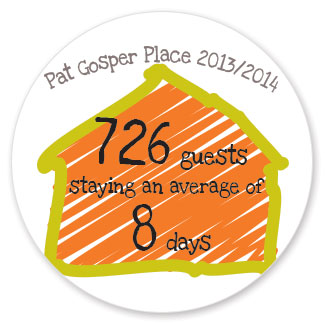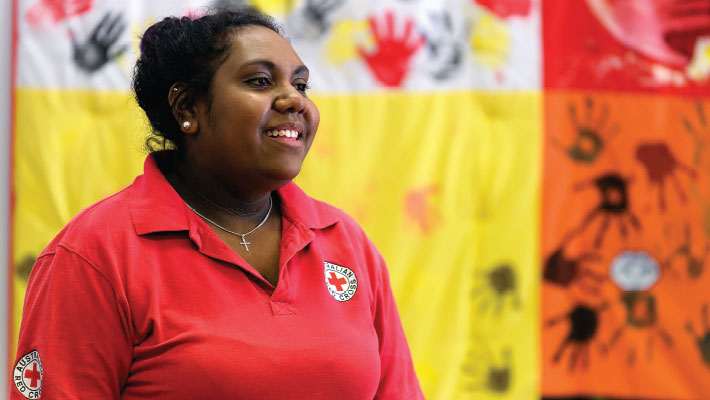Reflect, report, renew: our annual highlights
This year we carried out a number of innovations and improvements, both in our internal operations and the services that we provide.
Accessible, holistic health care

We opened the distinctive accommodation facility Cairns Wellbeing Centre – Pat Gosper Place in February 2014. The centre serves as a home away from home for people travelling to receive medical treatment in Cairns. It pilots a holistic model of health care, offering affordable accommodation in an inclusive, healing and culturally-appropriate environment where residents can access internal and external services on-site. Many of these people are from Aboriginal and Torres Strait Islander communities and the most remote parts of the country, where people are more likely to suffer reduced life expectancy, poorer health, and higher levels of disease and illness. Pat Gosper Place is the first of six Red Cross accommodation centres transitioning to wellbeing centres around Queensland.

Lajia Brown-Tamwoy is an Adnyamathanha and Torres Strait Islander woman. Lajia joined Red Cross in 2011 as an administration trainee and is now an HR Coordinator for South Australia. Photo: Australian Red Cross/Dan Carter
Action on Aboriginal and Torres Strait Islander employment
A practical plan was endorsed by our National Aboriginal and Torres Strait Islander Leadership Team to improve the engagement, support and retention of Indigenous staff. At 30 June 2014, 138 Aboriginal and Torres Strait Islander staff were employed (4.7% of our workforce), compared to 114 Indigenous staff a year earlier (3.8%). We are aiming to employ 6% Aboriginal and Torres Strait Islander staff in 2015.
A number of initiatives were implemented to support this goal. We strengthened the role of the Aboriginal and Torres Strait Islander Leadership Team, which provides strategic leadership to Red Cross regarding our engagement with Aboriginal and Torres Strait Islander peoples and communities. We also developed a cultural competence training package which is being rolled out to all staff and volunteers, and completed the implementation of our first Reconciliation Action Plan. This plan outlines the organisation’s practical actions to build strong relationships and enhanced respect between Aboriginal and Torres Strait Islander peoples and other Australians, thereby contributing to reconciliation in Australia.
Building disaster resilience
We continued to contribute to the Australian Business Roundtable for Disaster Resilience & Safer Communities, working collaboratively with the Insurance Australia Group, Investa Property Group, Munich Re, Optus and Westpac to champion national approaches to natural disaster resilience. The Roundtable launched a white paper in mid 2013, Building our Nation’s Resilience to Natural Disasters, which was informed by independent research commissioned from Deloitte Access Economics. This paper was one of the drivers for a Productivity Commission review into natural disaster funding, and recommendations so far drafted by the review reflect a number of proposals put forward both by the Roundtable and Red Cross. These proposals include substantial increases in funding to states for disaster mitigation activities, carrying the potential to create significant improvements in both individual and community resilience across Australia.
Equipment to excel
We continue to improve our administration and information technology processes as part of Program Novar, a review now in its fourth year which aims to ensure that we spend less time on administration and more time on improving the lives of vulnerable people. Program Novar is the largest information technology and process transformation program ever undertaken by Australian Red Cross, with a mandate to deliver better systems and processes to achieve consistency, efficiency and commonality across the organisation. Along with equipping us to work more productively, it will make us more accountable and transparent.
This year, key projects under Program Novar focused on updating and improving hardware and software across the organisation, including efficiency improvements to our finance software and starting development of point-of-sale software for our retail shops.
Protecting children
Over the past year we have pooled significant resources into renewing our child protection framework, improving our standing as a child-safe organisation. We developed and implemented a whole-of-organisation child protection policy, covering all Australian operations as well as our international programs and the work of our partners. Staff and volunteers are now required to sign a child protection code of conduct, and can refer to a handbook guiding implementation of the new policy as well as a suite of training resources. These are developing the knowledge and capacity of Red Cross people to provide safe environments for children, as well as to identify and respond to child safety concerns.
Our child safety reforms were recently commended when we were invited to work with the International Federation of Red Cross and Red Crescent Societies to support its development of a global child protection policy. In 2013/2014, Australian Red Cross assisted 27 Red Cross and Red Crescent National Societies, as well as 76 host organisations involved with the Australian Volunteers for International Development program, to put in place child protection policies and practices.


Let us know what you think
Any feedback or complaints about Red Cross or its work can be made at redcross.org.au or by calling 1800 811 700. Red Cross invites any feedback you may have regarding the Year in Review 2013/2014. Contact the editorial team at publications@redcross.org.au